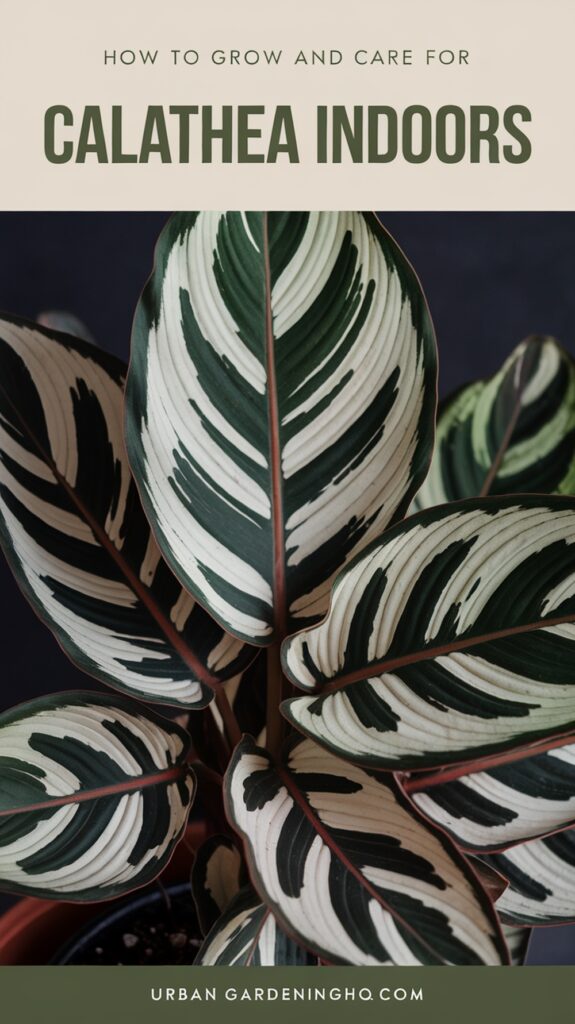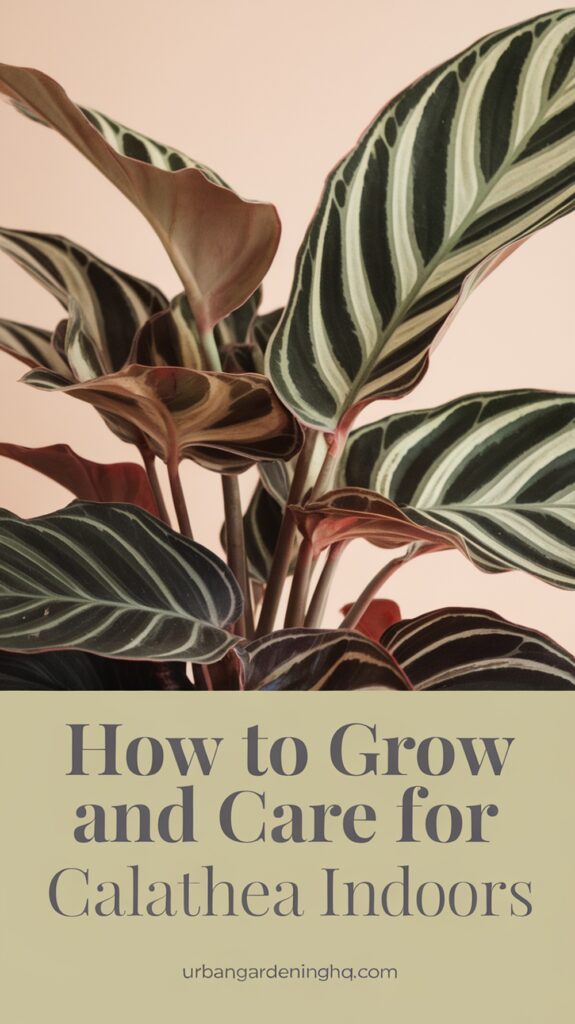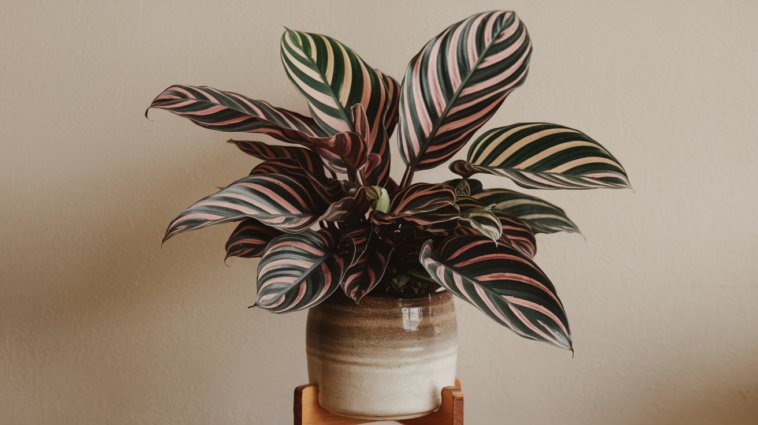I’ve always been drawn to the beauty of indoor plants, and Calathea plants are my top pick. Their vibrant leaves add elegance to any room, making them a favorite among houseplant lovers. I’m excited to share my knowledge on caring for these stunning plants.
Calathea plants are great because they can grow well in many environments. They’re perfect for both new and experienced plant lovers. Whether you want to beautify your home or explore indoor plants, Calathea is a great choice. In this article, I’ll cover the benefits of Calathea plants, their needs, and how to care for them.
The Mesmerizing World of Calathea Plants

Exploring Calathea plants reveals their special traits and flexibility. They come from the tropical Americas and love low light, perfect for indoors. Their beauty and easy care make them a favorite among plant lovers.
Calatheas excel as indoor plants because they can handle different settings. They prefer humid, warm places but also do well indoors. This makes them great for adding tropical vibes to your home with little effort. Some benefits include:
- Low-maintenance plants that are easy to care for
- Foliage plants with stunning, unique patterns and colors
- Tropical plants that can thrive in indoor conditions
Knowing where Calathea plants come from helps us value their unique qualities. They’re perfect for indoor spaces, whether you’re new to plants or a seasoned enthusiast. Calatheas are definitely worth checking out.
My Journey with Growing Calatheas at Home
I’ve always loved decorative plants, and Calatheas are my favorite. Growing them at home has been a fun journey. I’ve learned a lot about botany and gardening.
Understanding what Calatheas need is key. I’ve studied botany and gardening to create the best environment for them. This means the right light, water, and humidity, and using good soil and fertilizers.
Here are some important lessons I’ve learned:
- Choosing a variety that suits your lifestyle and environment
- Providing the right amount of light and water
- Maintaining a humid environment to promote healthy growth
- Using high-quality soil and fertilizers to support plant development
Follow these tips and keep learning about gardening and botany. You can enjoy growing Calatheas at home too.
Popular Calathea Varieties for Your Collection

Exploring Calathea, I’m thrilled to share top varieties for your indoor space. These air-purifying plants are not just pretty. They also clean the air, perfect for any home.
Choosing the right Calathea involves considering lighting, watering, and humidity. Here are some popular ones to start with:
Calathea Orbifolia
This variety boasts large, rounded leaves with silver and green markings. It’s a beautiful addition to any indoor plant collection, including succulents.
Calathea Medallion
The Calathea Medallion has striking leaves with green and white hues. It’s ideal for adding visual interest to your indoor space with unique plants.
Rattlesnake Calathea
This variety has long, narrow leaves with a rattlesnake-like pattern. It’s sure to be a conversation starter among your air-purifying plants.
Pinstripe Calathea
Lastly, the Pinstripe Calathea has beautiful, narrow leaves with striking pinstripe markings. It adds elegance to your indoor space with its houseplants.
Essential Light Requirements for Thriving Calatheas
As someone who loves plants, I’ve found that Calatheas do well in low light. They’re great for rooms with little natural light. But, they need the right light to grow and photosynthesize.
Calatheas, being tropical plants, need bright, indirect light. Direct sunlight can burn their leaves. To help, use grow lights to add to the natural light, which is key in winter when days are short.
Here are some tips for the right light for your Calatheas:
- Place your Calatheas near an east- or west-facing window for bright, indirect light.
- Use grow lights to supplement natural light, which is important in winter.
- Avoid direct sunlight to prevent leaf scorching.
By following these tips, you can make sure your Calatheas thrive. They’ll show off their beautiful leaves. Remember, finding the right balance in plant care is key. With the right light, your plants will stay happy and healthy.
Water and Humidity: The Key to Calathea Success

As I care for my indoor plants, I’ve learned the balance between water and humidity is key. Calathea plants need a careful balance to grow well. It’s important to water them right to avoid harming them.
To keep my Calathea happy, I focus on the right moisture level. I water when the top inch of soil is dry. Using room-temperature water helps avoid shocking the roots. These habits have greatly improved my plants’ health and look.
Humidity Levels for Optimal Growth
Keeping the right humidity is vital for Calathea plants. I use humidity trays and humidifiers to keep the air moist. Here are some tips:
- Place the plant on a tray filled with water and pebbles to increase the surrounding humidity
- Use a humidifier to maintain a humidity level of 50-60% in the room
- Monitor the humidity levels to ensure they don’t get too high, which can lead to root rot
By following these tips, I’ve created a great environment for my Calathea. With the right care, my plants grow well and make my home beautiful.
Soil and Fertilizer Needs for Healthy Growth
As a gardening enthusiast, I’ve learned that the right soil and fertilizer are key for Calathea plants. In botany, knowing each plant’s needs is vital for good care. Calatheas need well-draining soil that’s rich in organic matter.
Using a balanced fertilizer for indoor plants has helped my Calatheas grow well. It’s also important to repot them every 1-2 years. This refreshes the soil and gives them room to grow. Here are some key considerations for soil and fertilizer selection:
- Choose a potting mix for tropical plants like Calatheas
- Look for a balanced fertilizer with a 20-20-20 ratio
- Avoid over-fertilizing to prevent root and leaf damage
- Repot your Calathea in spring or summer when it’s pot-bound
By following these guidelines and using the right soil and fertilizer, you’ll help your Calathea thrive. With proper care and attention, you can enjoy the beauty of your Calathea. Gardening and botany offer many rewards.
Mastering Temperature Control for Your Calathea

I love tropical plants, and I know how important the right temperature is for them. Calathea plants are no different. They need a steady temperature to grow well, making them great for indoor spaces.
Calathea plants do best in temperatures between 65-75°F (18-24°C). This is the same range most foliage plants prefer. To keep this temperature, you can use thermostats or insulation in your home.
Ideal Temperature Ranges
Here are some tips to keep in mind:
- Avoid placing your Calathea near drafty windows or doors, as this can cause temperature fluctuations.
- Keep your Calathea away from heating or cooling vents, as these can also cause temperature changes.
- Use a thermometer to monitor the temperature in your home and make adjustments as needed.
Protecting from Drafts and Temperature Fluctuations
By following these tips and maintaining a consistent temperature range, you can help your Calathea thrive. Enjoy its beautiful tropical plants foliage all year round.
Common Calathea Problems and Solutions
I’ve dealt with many issues with my indoor plants, like Calatheas. These plants can face problems like brown edges, leaf curling, and pests. To keep your Calatheas healthy, it’s key to spot and fix these issues fast. For example, proper care can help prevent many problems.
Some common Calathea issues include:
- Brown edges, often from too much or too little water
- Leaf curling, a sign of low humidity or temperature changes
- Pests like spider mites or mealybugs, treatable with insecticidal soap
To solve these problems, give your Calatheas the right care. This means proper watering, humidity, and fertilization. By following these tips, you can enjoy your Calatheas and keep them healthy. They can add elegance to any room with your houseplants.
Propagation Methods I’ve Successfully Used
I love gardening and botany, and propagating Calatheas is very rewarding. It lets me share my plants with loved ones. I’ve tried division, stem cutting, and leaf cuttings to see what works best. Knowing how to care for plants has helped me grow my Calatheas collection.
Division is a top method for me. It means splitting the plant’s roots to make new ones. This way, I can share plants and keep the parent plant healthy. For more tips on Calathea propagation, check out this resource.
Some important tips for successful propagation include:
- Make sure the plant has enough light and humidity.
- Use good gardening practices like watering and fertilizing.
- Know the basics of botany and plant care to solve problems.
By following these tips and trying different methods, I’ve successfully grown my Calatheas. Gardening and plant care bring me joy and fulfillment.
Styling Your Space with Calathea Arrangements
Exploring Calathea plants has brought me joy. They make my indoor space look better. Mixing them with other plants creates beautiful arrangements. These add elegance and sophistication to any room.
When styling with Calathea arrangements, have fun and try new things. Think about the look you want. Do you like modern or bohemian styles? Choose plants and containers that match your vision. Calathea plants fit well in many settings, making them great for indoor use.
Creating Plant Groupings
I love making plant groupings with Calathea. It’s about mixing plants with different textures and heights. Here are some tips:
- Choose plants with varying leaf shapes and sizes to add depth and visual interest
- Experiment with different container sizes and styles to add texture and personality
- Don’t be afraid to mix and match different types of indoor plants to create a unique and eclectic look
Choosing the Perfect Containers
Choosing the right containers for Calathea arrangements is fun. You can pick from modern to vintage pots. The container’s color and style should match your space and plants. With creativity, you can make stunning Calathea arrangements.
Conclusion: Embracing the Beauty of Calathea Care
As we wrap up our journey into the world of Calathea plants, I hope you now see their beauty. Plant care for Calatheas needs some extra work, but their beauty and air-purifying skills make it worth it. Whether you’re new to houseplants or experienced, embracing Calathea care can change your home.
With the tips we’ve shared, you’re ready to give your Calatheas the care they need. You’ll learn about light, water, and humidity, and how to handle common issues. Enjoy the small wins and don’t worry about the occasional problem – it’s all part of caring for plants.
As you grow your Calathea collection, you’ll see their leaves move in a beautiful dance. They add elegance to your home. Enjoy watching them grow and be proud of caring for these amazing plants. Calatheas remind us of nature’s beauty and our role as plant caretakers.


